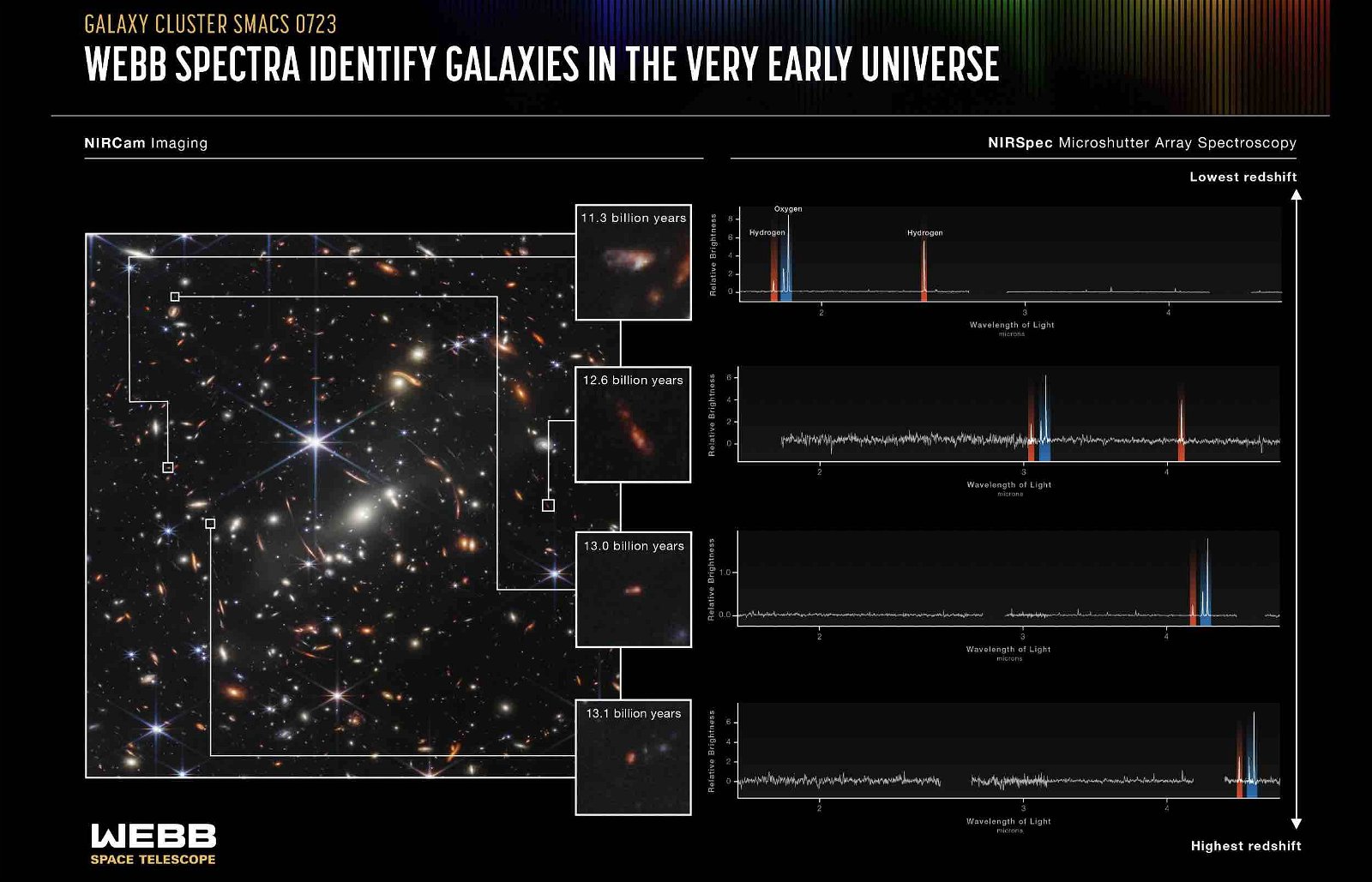The James Webb Space Telescope is changing astronomy in many ways, from peering into the atmosphere of exoplanets to capturing stunning images of distant cosmic phenomena. But perhaps its greatest scientific contribution is its ability to observe galaxies that are so distant that looking at them is like looking back in time. Projects like Webb’s CEERS (Cosmic Evolution Early Release Science) survey are scanning the sky to pick out some of the oldest galaxies we’ve ever seen.
When scientists first turned Webb toward apparently empty patches of sky to look for these distant galaxies, they found something very strange. They didn’t just find a few very old galaxies, dating back as much to just a few hundred million years after the Big Bang — they found far more of these galaxies than anyone had predicted.
“The theoretical models didn’t predict that these should be there,” one of the leading CEERS researchers, Micaela Bagley of the University of Texas, told The Debrief. “We still don’t yet know how you can see a galaxy that bright, that early.”
One particular galaxy jumped out of the CEERS data straight away. Maisie’s galaxy, named after the daughter of one of the researchers, is 13 billion years old, making it one of the oldest galaxies ever observed. And it is much brighter and much bluer than anyone predicted.
“When we found Maisie’s galaxy, the surprising part was — how is it in the universe?” Bagley said. “It’s exciting that this is the universe we live in. It’s a universe with a ton more galaxies than we thought.”
How the James Webb Space Telescope Spots Ancient Galaxies
Webb is able to detect extremely distant galaxies because its instruments operate in the infrared wavelength. A small handful of extremely distant galaxies had been detected previously by the Hubble Space Telescope, which operates primarily in the optical light wavelength, which is equivalent to what human eyes can see. But as galaxies move further and further away from us due to the expansion of the universe, their light is shifted toward the red end of the spectrum in a process called redshift.
The extremely distant galaxies that early universe researchers are interested in have light that is redshifted so far that it is no longer visible in the optical and can only be seen in the infrared. So Hubble’s instruments were pushed to the limits to detect even a few of these galaxies, while Webb was able to detect many of them incredibly quickly — within a few days of the telescope beginning its science operations.
When discussing these galaxies, scientists typically talk about them in terms of their age rather than their distance: You’ll see researchers describe a galaxy as being from the first few hundred million years after the Big Bang rather than being located billions of miles from Earth. That’s also because of the expansion of the universe, which creates a moving frame of reference that makes it hard to describe distance meaningfully.
Examples include galaxies like Maisie’s galaxy, which is described as being 13 billion years old. “The light has traveled 13 billion years to get to us, but if we could see Maisie’s galaxy today, it is much much further away because in that time, the universe has kept expanding and accelerated its expansion,” Bagley explained. “The time the light has spent traveling to us gives us more concrete information about when in the universe we’re observing these galaxies.”
Something’s Up With Early Galaxies
Scientists had already produced models of what early galaxies would be like, but Webb contradicted them almost immediately. As soon as scientists began looking for early galaxies, they found far more of them than they had predicted and found that they were much brighter too.
At first, it seemed like the issue could be due to the calibration of Webb’s instruments, an ongoing process that took some time, even when the telescope began its operations. But subsequent observations have backed up this early and puzzling finding: what we see with Webb doesn’t make sense with the models of the universe we have.


The high number of early galaxies detected suggests that there’s something we don’t yet understand about galaxy formation, and how that process has changed between billions of years ago and now. The fact that the galaxies are brighter than expected is intriguing too, and could have several explanations. These galaxies could actually be giving off more light, or they could be more massive, or it could be a combination, as the two factors are related.
“So if you have small galaxies with a ton of stars, is that what’s going on? Or do you have big galaxies with a normal amount of stars?” Bagley summed up the big question. “It could be both or either.”
The early universe had galaxies with potentially as many stars as the Milky Way, and we don’t have an explanation for how these stars could have formed so early or in such great numbers. There’s currently no consensus on what is the root of the discrepancy between the models we have and the data we observe with Webb. The answer could be related to dark matter and its role in the early universe, or it could be that the way early galaxies were formed was spurred on by forces that haven’t been considered yet.
Physics of the Early Universe
Even before the James Webb Space Telescope, scientists knew that the early universe was a very different place from the universe today. Its galaxies were made almost entirely of hydrogen and helium, were shaped by tendrils of dark matter, and hosted enormous, bright stars that lived fast and died young.
While the laws of physics haven’t changed over the past billions of years, the scale of the universe has — and that affects how those physical laws apply to galaxies. When the universe was smaller and denser, that affected the ways in which stars form in complex ways. “If the universe is smaller, the density inside galaxies and outside galaxies is probably higher,” Bagley explained. “If it’s dense and hot, the gas won’t collapse to form stars. If it’s dense and cold, then you could get a ton more stars.”
Another way in which the early universe was fundamentally different is in its overall chemical composition. Heavy elements like metals were almost entirely absent in the early universe because these elements were primarily formed within stars and spread by their explosive deaths, called supernovae. It took several generations of stars to spread these heavier elements through the universe and to be absorbed into stars similar to those we see today.
The hypothetical earliest stars in existence are referred to as Population III stars (today’s young stars are Population I stars, and the numbering counts backward in age). They were much bigger, heavier, and bluer than stars today, and they gave off more ionizing radiation. Those differences are because of the way stars generate heat and light in a process called fusion.
“If a star is made only of hydrogen and helium, to do fusion the star has to be hotter and denser than a star that has carbon, nitrogen, oxygen,” Bagley explained. “There’s a different chemical pathway to create fusion,” and that requires a larger size and more mass to support it.
No one has ever observed a Population III star before, and finding one is one of the holy grails of modern astronomy. Bagley believes it could be possible to find one using Webb: “It’s hopeful, and it’s optimistic, but I do think it’s realistic,” they said.
A baby picture of the Milky Way
All of this discussion of billion-year-old history might seem rather abstract. But in fact, it’s directly relevant to understanding the universe as we see it today, and as the James Webb Space Telescope is revealing in greater detail than ever before.
That’s because astronomy operates on such long-time scales that we can’t watch objects like galaxies across their lifespans. Most galaxies we see around us today look like the Milky Way, but we can’t see them develop over time. To study that development, we need to look for distant and ancient galaxies, which Bagley refers to as “baby pictures” of the Milky Way.
“This is all about understanding how our Milky Way formed,” they said. “It sounds cliche, but before we can understand where we are and where we’re going, we need to understand where we came from.”
Georgina Torbett is a freelance space reporter. Her past work has been featured at The Verge, Digital Trends, SlashGear, Inverse, Futurism, and Engadget.

